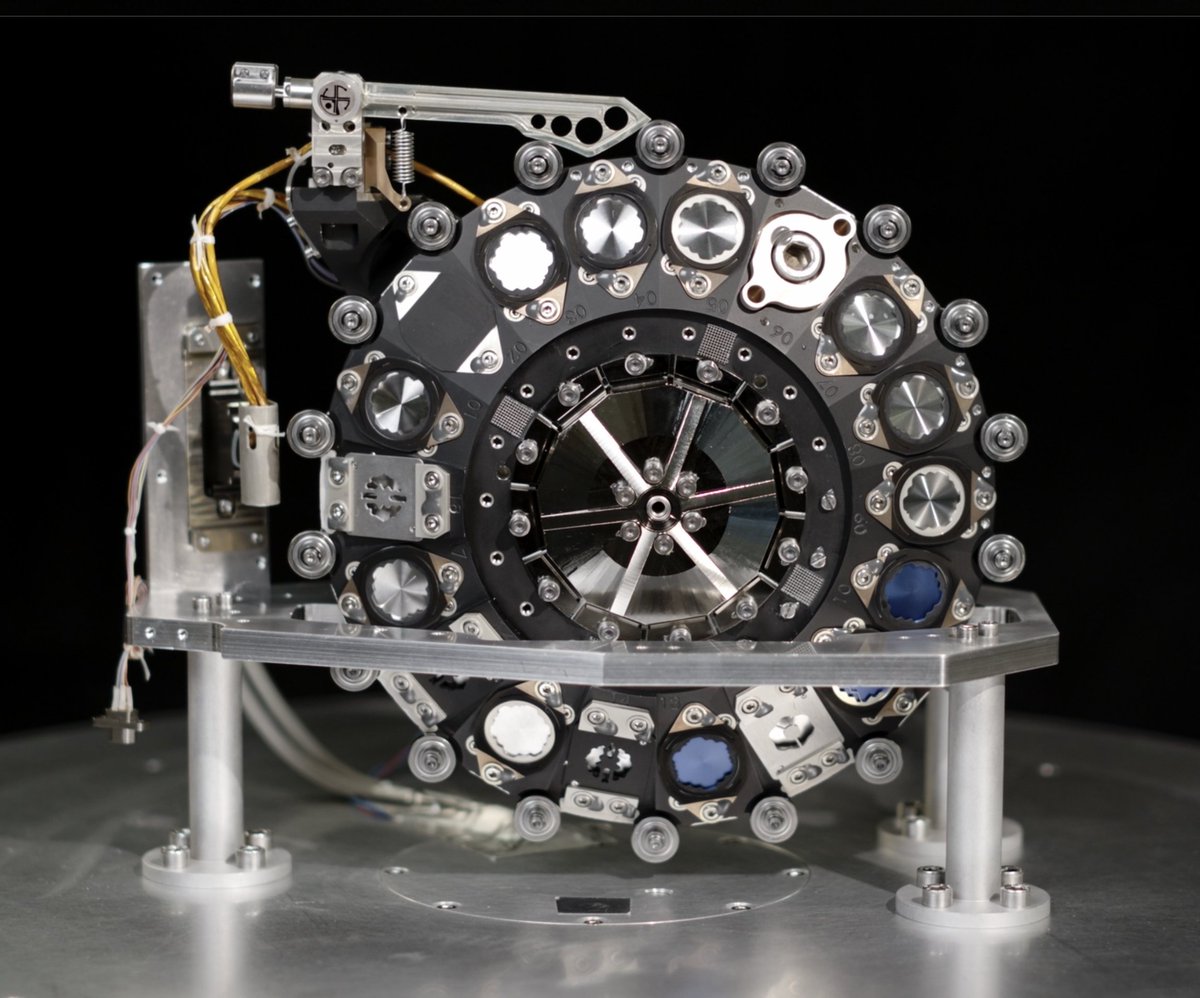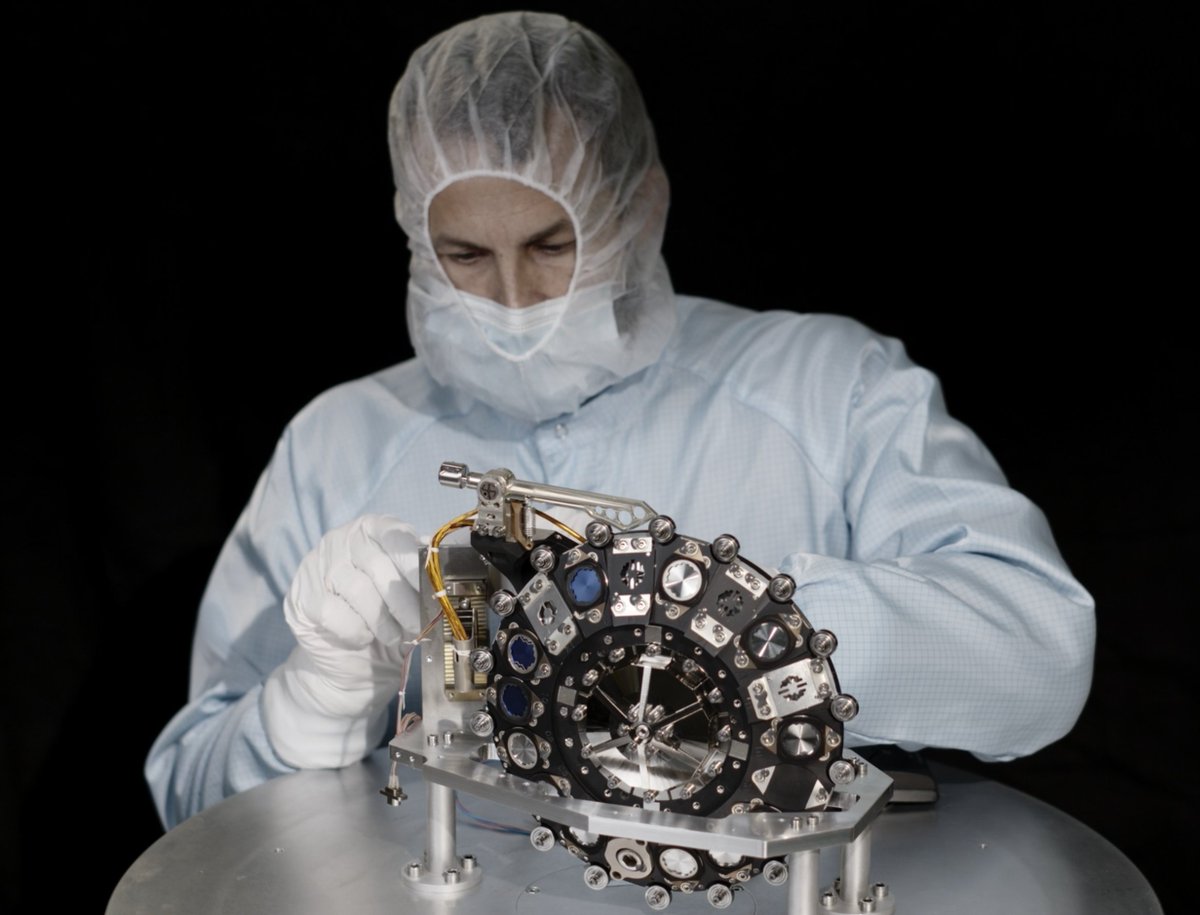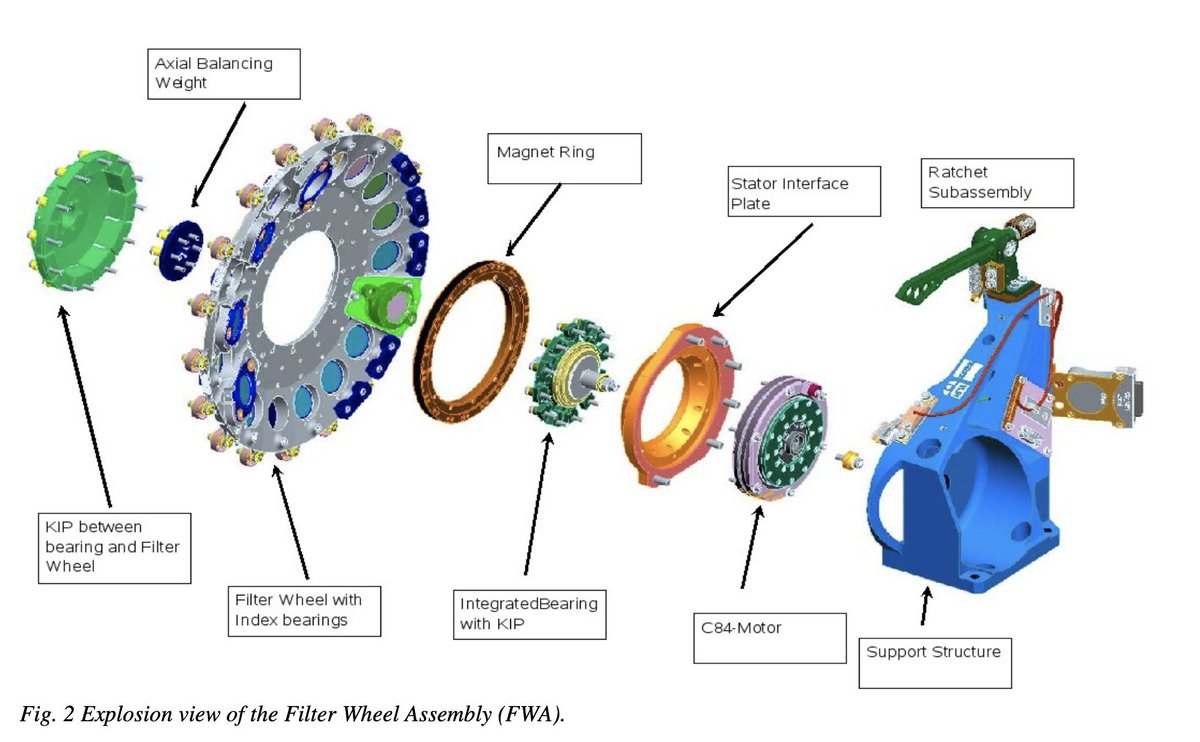
OK, Internet. Are you ready for our gallery "The Beauty of the @NASAWebb @ESA_Webb MIRI Instrument Filter wheel"? Because it *is* beautiful, and @mpi_astro is quite proud of contributing to that amazing space telescope! Let's start with the classic face-on look. 1/ 

Also available in the Roy Lichtenstein (?) version. (OK, this is actually the 3D design by @mpi_astro and @ZEISS_Group, taken from this 2005 press release. We've been working for a long time on this!) 

With that amount of elegance and beauty, you won't be surprised to learn that the MIRI filter wheel has been doing some modelling gigs. Here it is as one of the faces of the IAU's strategic plan 2020-2030.
https://twitter.com/IAU_org/status/11095907480795013153/
Have a look at how closely the contour follows the distinctive shape of the JWST's mirror. But again, in this qualification model, you do not see the real filters. Instead, we have substitute filters with the same thermal properties. Seeing the real filters will involve 5/ 

uhm, a certain amount of travel, by now? (You can get the details from this handy travel guide: webb.nasa.gov/content/webbLa… ) 6/
Of course, it's not just about beauty. Just as with many top design object, it's about beauty *and* functionality! Or, as the MIRI design motto went: "Form follows filter function". Here is a handy diagram from jwst-docs.stsci.edu/jwst-mid-infra… - meet the MIRI filters! 7/ 

And we were quite flattered with what @coreyspowell said about the filter wheel. Yes, it is both beautiful and powerful!
https://twitter.com/coreyspowell/status/14813147818187694088/
Also we like the phrase "Each of the 18 elements here provides a distinct perspective on the universe." But we'll let you in on a secret, or several secrets. All in the interest of, uhm, unfiltered transparency? First of all, one of those filters is completely opaque. 9/
Now you might well say: Firmly closing your eyes *is* a distinct perspective on the universe. Any you'd be right. But for astronomers, having an opaque "filter" here is essential. When we take pictures, we want to make sure that we know about all the kinds of noise that 10/
will be part of our picture. It's a way of being aware of your limitations, so to speak. In order to find out how much noise your detector contributes even when there's no light falling onto it, you take "darks". And for that, you shield your detector. By putting in an 11/
opaque "filter". That is what that opaque thingy does. And it's important – it helps put the other distinct perspectives on the universe into perspective, so to speak. 12/
By now you might be wondering: How big is this filter wheel, anyway? Webb itself, after all, is rather enormous. The filter wheel is much smaller, though. It's in the instrument, and by then all the light collected by the 6.5 m mirror has been concentrated into a narrow beam. 13/
So here, for scale, is a fairly average-size human. He is Oliver Krause from @mpi_astro, and he is the group leader of the IR Space Astronomy Research Group at the institute, where the filter wheel was designed. 14/ 

But you're not here for pictures of humans. You're here for pictures of the MIRI filter wheel! There you go. You're welcome. 15/ 

Because what is more beautiful than a picture of this kind of elegant engineering marvel, set to play a role in the exploration of the first stars and galaxies? 16/ 

Oh, you're saying that *moving* pictures might be even more beautiful. Hold on, let's see if we can upload this. Presenting among other things: The unique sound of the MIRI filter wheel. Which will never be heard in the original, given the vacuum of space. 17/
Have a more detailed look at the way the gentle ratchet (tm) is turning. You know, the one that makes sure all the filters are exactly where they should be, for each position: 18/
(OK, quick correction: It's not a ratchet, since the filter wheel can turn in both directions. We are probably talking about the pawl. Bear with us.) 19/
Anyway, this is what we are talking about. The lever thing that goes up and down, and makes sure the wheel is positioned correctly. Do you see the cross where the axle should be? 20/ 

Now, as an engineer familiar with how things work here on Earth, you might think that behind the cross, there is some kind of bearing, holding the axle that lets the lever (pawl?) rotate. 21/ 

But you would be WRONG! 22/
[cackles in evil space engineer] 23/
An axle with a bearing, you say? May be with some lubrication to make sure things are running smoothly?
Oh, you sweet Earth-engineering child. 24/
Oh, you sweet Earth-engineering child. 24/
And in the cold and harsh environment of space. MIRI is cooled down to 7 Kelvin (otherwise, it wouldn't be able to make mid-infrared observations - you'd only see radiation from the instrument itself). At those temperatures, lubricant turns into something with the 26/
lubrication efficiency of common or garden sand. Ouch! Doesn't that make your head explode? 27/
Back to the serious stuff. "+" marks the spot, the spot where two flat springs, orthogonal to each other, are fixed to the frame, and fixed to the lever. There is no axle that rotates. There is an axle-like spring that can deform in just the right way for the lever to move. 29/ 

No rotating parts, no lubricants - that is how you do precision mechanics in space! And it is significantly different from how you do precision mechanics on Earth. 30/
And don't get us started on the thermal properties of the materials involved. You see, before the start, the MIRI Filter Wheel is sitting at around in fairly warm humid jungle air. Our alumnus @markmccaughrean had some images of that:
https://twitter.com/markmccaughrean/status/147904031443016908831/
There it is. The best christmas present astronomers could hope for. Gift-wrapped. But not air-conditioned. It's a jungle. It's not exactly cold.
https://twitter.com/markmccaughrean/status/147431524681487564833/
This, on the other hand, are the current temperatures on the warm and cold side of the JWST, courtesy of webb.nasa.gov/content/webbLa… (a) is the average temperature of the sunshield structure. (b) is the average temperature of the spacecraft bus. So far, so good. 34/ 

But now, come to the cold side! (c) is the average temperature of the big shiny golden mirror. (d) is the average temperature of the instrument radiator. Near that are the instruments. -200 degrees Celsius! Or -328 F for our unit-challenged transatlantic friends. 35/ 

OK, we were a bit over-enthusiastic there. Some dry lubricants work under those conditions, and are in fact used in the main bearing for the filter wheel.
https://twitter.com/mpi_astro/status/1481409344436592643
MIRI, as a mid-infrared instrument, will be even cooler than that. Operating temperature 7 Kelvin. -266 degrees Celsius. -447 Fahrenheit. I think we're not in Canada any more, MIRI. 36/
(OK, a rather silly Wizard-of-Oz pun. But Canada plays a role in the JWST: The Canadian Space Agency @csa_asc is a part of the partnership for the JWST, together with @NASA and @ESA.) 37/
Anyway, where were we? The materials! So the MIRI Filter Wheel is designed for a temperature range of roughly 280 Kelvin! Take a look at the objects around you. What is their temperature range? I just had a look for my consumer camera here at home. 40 measly Kelvin range. 38/
From 0 Celsius to 40 Celsius. That is the environment the camera will work in. (Come to think of it, the environment in which *I* am willing to work has an even smaller temperature range.) 39/
OK, so the filter wheel doesn't really have to *work* in the hot and humid jungle. But if our colleagues had chosen the wrong materials, then between those conditions and the cool operating conditions, the mechanism would jam, and might not operate at all afterwards! 40/
So in designing the MIRI Filter Wheel - and if you've read this far, you deserve another glamour shot, here you go - it was very important to choose materials that work with each other - that have just the right thermal expansion properties so the assembly will remain 41/ 

un-jammed both in a humid jungle and operating close to what physicists call absolute zero. Our institute's precision engineering department - yes, we not only have scientists, we have top craftspeople too! - specializes in that kind of space engineering design. 42/
If you have a space mechanical engineering problem, if no-one else can help, and if you can find them, may be you can hire: the MPIA-Team (precision engineering department). 43/ 

Anyhoo, that concludes tonight's thread. If we, the social media team, got any of the details wrong, there are many knowedgeable people who will set us straight. Please note we already backtracked a bit on the lubrication issues. Any remaining mistakes are not the fault of 44/
the amazing team at @mpi_astro who designed the beautiful MIRI Filter Wheel - you want another image? Sure, have another image, here you go: 45/ 

...as we were saying: not the fault of the amazing team who designed this. All mistakes are the fault of the man behind the curtain, whom you can reach for under @mpoessel. (If you have no complaints, pay no attention to that man behind the curtain.) 46/ 

If you feel inspired to create any MIRI Filter Wheel memes of your own, here is a picture with alpha channel (hopefully Twitter does not remove that?) for your use. Be sure to link this thread if you post your results! 47/ 

(Hm, it does seem to get transformed to a JPG with a white background. Bummer. But if you build memes, you can probably remove white backgrounds, yes?) 48/
We'll leave you with one of our @mpi_astro directors, @lkreidberg , talking about what she intends to use the JWST for. After all, that is what all this is about: Doing really, really good science! Good-bye, and keep The Wheel in your thoughts! 49/49
Anyway, take what is written above about lubrication with a grain of salt (!), or possibly molybdenum bisulfide. There *is* "dry lubrication" in space, but for the moving lever, that was not the right solution. And follow #WebbSeesFarther and @ESA_Webb and @NASAWebb
Somebody asked about where the images were from. Most of them are just screenshots from the HD videos that are linked at the bottom left of this press release detailing the MPIA involvement in Webb: mpia.de/news/science/2…
@NASAWebb @ESA_Webb It's probably too late to add #TheAmazingMIRIFilterWheel as a hashtag, right? Right. Darn, we should have done that in the first place. That is what happens when the flow sweeps the social media team away after midnight.
• • •
Missing some Tweet in this thread? You can try to
force a refresh






